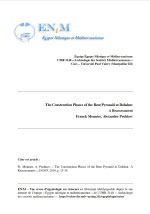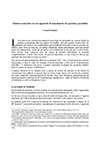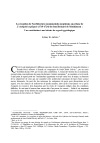Dahshur
« The Construction Phases of the Bent Pyramid at Dahshur. A Reassessment »
ENiM 9, 2016, p. 15-36.
 Les particularités architecturales de la pyramide rhomboïdale de Snéfrou à Dahchour-Sud inspirent deux courants d’interprétation. Le premier consiste à y voir l’expression symbolique délibérée d’une dualité et, le second, des modifications en raison de problèmes structuraux survenus au cours du chantier. Cet article fait le point sur l’état de l’archéologie en y apportant des observations inédites et complémentaires. Certains détails jusqu’alors passés inaperçus, ainsi que la pathologie de l’édifice, amènent à confirmer que les bâtisseurs ont apporté plusieurs changements à leur projet, mais aussi à en saisir les raisons. Une révision complète de l’histoire du monument est ainsi proposée en guise de conclusion.
Les particularités architecturales de la pyramide rhomboïdale de Snéfrou à Dahchour-Sud inspirent deux courants d’interprétation. Le premier consiste à y voir l’expression symbolique délibérée d’une dualité et, le second, des modifications en raison de problèmes structuraux survenus au cours du chantier. Cet article fait le point sur l’état de l’archéologie en y apportant des observations inédites et complémentaires. Certains détails jusqu’alors passés inaperçus, ainsi que la pathologie de l’édifice, amènent à confirmer que les bâtisseurs ont apporté plusieurs changements à leur projet, mais aussi à en saisir les raisons. Une révision complète de l’histoire du monument est ainsi proposée en guise de conclusion.
 The architectural peculiarities of the Bent pyramid built by Snefru at South Dahshur are the subject of two currents of interpretation. The first one consists of seeing the symbolic and deliberate expression of a duality in the design, and the second one, modifications due to structural problems that occurred during the construction work. This article reviews the archaeological situation by bringing unpublished and additional observations into the discussion. Some details that have been unnoticed by commentators so far, as well as a structural pathology of the building, lead to confirmation that the builders changed their project several times, but also reveal the reasons for these changes. A complete revision of the history of the monument is then suggested as a conclusion.
The architectural peculiarities of the Bent pyramid built by Snefru at South Dahshur are the subject of two currents of interpretation. The first one consists of seeing the symbolic and deliberate expression of a duality in the design, and the second one, modifications due to structural problems that occurred during the construction work. This article reviews the archaeological situation by bringing unpublished and additional observations into the discussion. Some details that have been unnoticed by commentators so far, as well as a structural pathology of the building, lead to confirmation that the builders changed their project several times, but also reveal the reasons for these changes. A complete revision of the history of the monument is then suggested as a conclusion.
 Consulter cet article (47862) -
Consulter cet article (47862) -  Télécharger cet article au format pdf (22864)
Télécharger cet article au format pdf (22864)
« DonnĂ©es nouvelles sur les appareils de maçonnerie des grandes pyramides »
ENiM 13, 2020, p. 237-261.
 Une campagne de relevés photogrammétriques effectuée en 2018 a permis de numériser les grandes pyramides construites durant les IIIe et IVe dynasties. Sans prétendre à l’exhaustivité, celle-ci s’était donné comme objectif de promouvoir cette technologie dans l’étude des grands monuments égyptiens. L’analyse des données a permis d’effectuer des observations et des mesures précises sur des parties extérieures jusque-là inaccessibles. Cet article rassemble les données les plus significatives recueillies sur les appareils de maçonnerie des pyramides de Snéfrou situées à Meïdoum et Dahchour, et de la pyramide de Khéphren à Giza.
Une campagne de relevés photogrammétriques effectuée en 2018 a permis de numériser les grandes pyramides construites durant les IIIe et IVe dynasties. Sans prétendre à l’exhaustivité, celle-ci s’était donné comme objectif de promouvoir cette technologie dans l’étude des grands monuments égyptiens. L’analyse des données a permis d’effectuer des observations et des mesures précises sur des parties extérieures jusque-là inaccessibles. Cet article rassemble les données les plus significatives recueillies sur les appareils de maçonnerie des pyramides de Snéfrou situées à Meïdoum et Dahchour, et de la pyramide de Khéphren à Giza.
 A new photogrammetric survey was carried out in 2018 to digitize the visible surfaces of the great 3rd and 4th dynasty pyramids of Egypt. While certainly not exhaustive, the intention of the campaign was to demonstrate and promote this new 3D technology for the study of ancient Egyptian monuments. The data collected this way facilitated observation and the accurate measurement of previously inaccessible external parts of the architecture. This article brings together the most significant new data collected during the survey and presents new information and analysis regarding the stones of the Pyramids of Snefru at Meidum and Dahshur, and the pyramid of Khafre at Giza.
A new photogrammetric survey was carried out in 2018 to digitize the visible surfaces of the great 3rd and 4th dynasty pyramids of Egypt. While certainly not exhaustive, the intention of the campaign was to demonstrate and promote this new 3D technology for the study of ancient Egyptian monuments. The data collected this way facilitated observation and the accurate measurement of previously inaccessible external parts of the architecture. This article brings together the most significant new data collected during the survey and presents new information and analysis regarding the stones of the Pyramids of Snefru at Meidum and Dahshur, and the pyramid of Khafre at Giza.
 Consulter cet article (44590) -
Consulter cet article (44590) -  Télécharger cet article au format pdf (18216)
Télécharger cet article au format pdf (18216)
« La rĂ©ception de l’architecture monumentale Ă©gyptienne au prisme de L’AntiquitĂ© expliquĂ©e (1719-1724) de dom Bernard de Montfaucon : Une contribution Ă une histoire du regard Ă©gyptologique »
ENiM 14, 2021, p. 285-313.
 Ce papier aborde une page d’histoire du regard pré-égyptologique sur l’architecture égyptienne à travers L’Antiquité expliquée en figures (1714-1724), ouvrage élaboré par dom Bernard de Montfaucon (1655-1707). Dans sa tentative d’approche de l’histoire culturelle de l’Antiquité, cet antiquaire réunit non seulement un des plus grand ensemble d’objets-images égyptiens de son temps, mais réussit, à partir de la lecture des rares voyageurs contemporains ayant remonté la vallée du Nil – le Rouennais Paul Lucas, le Hollandais Corneille Le Brun (Cornelis De Bruijn), le Parisien Jean Thévenot –, à fournir au lecteur quelques clés sous forme de commentaires permettant de comprendre, selon les critères de son temps, les descriptions de quelques monuments dont les « inventeurs » sont parfois lesdits voyageurs. D’une part la Grande Pyramide, la première description de la « Pyramide rouge » de Snéfrou à Dahchour, le grand Sphinx ; d’autre part le propylône du temple d’Haroëris à Qous (compris comme le « tombeau de Cléopâtre »), le mammisi d’Harprê à Armant (« Temple d’Hermant »), le temple d’Hathor à Dendara (temple ou palais ? « Temple de Sérapis » ?). Analyses curieuses, mais hautement significatives de la culture des XVIIe-XVIIIe siècles dont les paradigmes se rapportent à l’architecture classique et au De Architectura de Vitruve.
Ce papier aborde une page d’histoire du regard pré-égyptologique sur l’architecture égyptienne à travers L’Antiquité expliquée en figures (1714-1724), ouvrage élaboré par dom Bernard de Montfaucon (1655-1707). Dans sa tentative d’approche de l’histoire culturelle de l’Antiquité, cet antiquaire réunit non seulement un des plus grand ensemble d’objets-images égyptiens de son temps, mais réussit, à partir de la lecture des rares voyageurs contemporains ayant remonté la vallée du Nil – le Rouennais Paul Lucas, le Hollandais Corneille Le Brun (Cornelis De Bruijn), le Parisien Jean Thévenot –, à fournir au lecteur quelques clés sous forme de commentaires permettant de comprendre, selon les critères de son temps, les descriptions de quelques monuments dont les « inventeurs » sont parfois lesdits voyageurs. D’une part la Grande Pyramide, la première description de la « Pyramide rouge » de Snéfrou à Dahchour, le grand Sphinx ; d’autre part le propylône du temple d’Haroëris à Qous (compris comme le « tombeau de Cléopâtre »), le mammisi d’Harprê à Armant (« Temple d’Hermant »), le temple d’Hathor à Dendara (temple ou palais ? « Temple de Sérapis » ?). Analyses curieuses, mais hautement significatives de la culture des XVIIe-XVIIIe siècles dont les paradigmes se rapportent à l’architecture classique et au De Architectura de Vitruve.
 This paper deals with a page of history of the pre-egyptological vision on Egyptian architecture through L'Antiquité expliquée en figures (1714-1724), elaborated by dom Bernard de Montfaucon (1655-1707). In his attempt to approach the cultural history of Antiquity, this antiquarian not only brings together one of the largest collections of Egyptian objects of his time, but also succeeds, from the reading of the rare contemporary travelers who sailed up the Nile valley – the Rouen native Paul Lucas, the Dutchman Corneille Le Brun (Cornelis De Bruijn), the Parisian Jean Thévenot –, in providing to the reader some keys in the form of commentaries allowing to understand, according to the criteria of his time, the descriptions of some monuments whose discoverers are sometimes the said travelers. On the one hand the Great Pyramid, the first description of the “Red Pyramid” of Snefru in Dahshur, the great Sphinx; on the other hand the propylon of the temple of Haroeris at Qus (understood as the “tomb of Cleopatra”), the mammisi of Harpre at Armant (“Temple of Hermant”, the temple of Hathor at Dendara (temple or palace? “Temple of Serapis”?). Curious analyses, but highly significant of the culture of the XVII-XVIIIth centuries whose paradigms are related to classical architecture and the De Architectura of Vitruvius.
This paper deals with a page of history of the pre-egyptological vision on Egyptian architecture through L'Antiquité expliquée en figures (1714-1724), elaborated by dom Bernard de Montfaucon (1655-1707). In his attempt to approach the cultural history of Antiquity, this antiquarian not only brings together one of the largest collections of Egyptian objects of his time, but also succeeds, from the reading of the rare contemporary travelers who sailed up the Nile valley – the Rouen native Paul Lucas, the Dutchman Corneille Le Brun (Cornelis De Bruijn), the Parisian Jean Thévenot –, in providing to the reader some keys in the form of commentaries allowing to understand, according to the criteria of his time, the descriptions of some monuments whose discoverers are sometimes the said travelers. On the one hand the Great Pyramid, the first description of the “Red Pyramid” of Snefru in Dahshur, the great Sphinx; on the other hand the propylon of the temple of Haroeris at Qus (understood as the “tomb of Cleopatra”), the mammisi of Harpre at Armant (“Temple of Hermant”, the temple of Hathor at Dendara (temple or palace? “Temple of Serapis”?). Curious analyses, but highly significant of the culture of the XVII-XVIIIth centuries whose paradigms are related to classical architecture and the De Architectura of Vitruvius.
 Consulter cet article (32145) -
Consulter cet article (32145) -  Télécharger cet article au format pdf (15467)
Télécharger cet article au format pdf (15467)
ENiM 18 - 2025
4 article(s) - 11 mars 2025.
ENiM 1 à 18 (2008-2025) : 223 articles
4 019 413 téléchargements
8 332 175 consulations.
Index des auteurs

Mots clés

Derniers articles : 
Robert Steven Bianchi
Duplication and Continuity
(ENiM 18, p. 13-36 — 11 mars 2025) 
Frédéric Mougenot
Rénénoutet à la porte de la maison
(ENiM 18, p. 1-12 — 29 janvier 2025) 
CENiM - Mise en ligne des volumes Ă©puisĂ©s : 
 Anne-Sophie von BOMHARD DĂ©cans Ă©gyptiens, CENiM 23, Montpellier, 2020 — (2020)
Anne-Sophie von BOMHARD DĂ©cans Ă©gyptiens, CENiM 23, Montpellier, 2020 — (2020) 
 Jean-Claude Grenier L'Osiris ANTINOOS, CENiM 1, Montpellier, 2008 — (26 dĂ©cembre 2008)
Jean-Claude Grenier L'Osiris ANTINOOS, CENiM 1, Montpellier, 2008 — (26 dĂ©cembre 2008) 
TDENiM - Mise en ligne des volumes Ă©puisĂ©s : 
 Twitter
Twitter 3615172 visites - 4570 visite(s) aujourd’hui - 185 connecté(s)
© ENiM - Une revue d’égyptologie sur internet
Équipe Égypte Nilotique et Méditerranéenne - UMR 5140 - « Archéologie des Sociétés Méditerranéennes » (Cnrs) - Université Paul Valéry - Montpellier III
























 Contact
Contact
 Abonnez-vous !
Abonnez-vous ! Équipe Égypte Nilotique et Méditerranéenne
Équipe Égypte Nilotique et Méditerranéenne UMR 5140 « Archéologie des Sociétés Méditerranéennes » (Cnrs)
UMR 5140 « Archéologie des Sociétés Méditerranéennes » (Cnrs) Université Paul Valéry - Montpellier III
Université Paul Valéry - Montpellier III